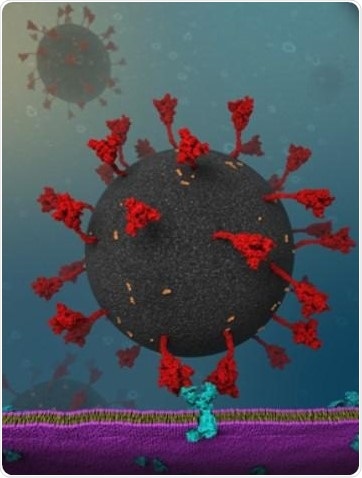Bioengineering scientists from Lehigh University have now detected a formerly unknown interaction between the spike (or “S”) protein of SARS-CoV-2—the virus responsible for causing COVID-19—and receptors in human cells.

The S protein has a highly flexible stalk that is composed of two independent joints. The flexible motions of the S proteins enable the receptor-binding domain to have various orientations and the most probable S protein configurations are competent for ACE2 binding. Image Credit: Dr. Yeolkyo Choi.
This latest data may lead to the development of novel approaches to inhibit the entry of SARS-CoV-2 into human cells.
X. Frank Zhang and Wonpil Im already knew from the latest studies that the interaction between the angiotensin-converting enzyme 2 (ACE2) receptors in human cells and the SARS-CoV-2 spike protein is more powerful when compared to the interaction between the same receptors and the structurally identical spike protein of SARS-CoV-1—the virus that caused the SARS outbreak in 2002-2004.
Our goal was to characterize SARS-CoV-2 and study the protein-protein interactions during its invasion of human cells to provide more insights into the mechanisms that make this first step in its successful invasion process possible.”
X. Frank Zhang, Associate Professor in Bioengineering and Mechanical Engineering & Mechanics, Lehigh University
The researchers’ discoveries have appeared in an article, known as “Biomechanical characterization of SARS-CoV-2 spike RBD and human ACE2 protein-protein interaction,” in a special edition of the Biophysical Journal, titled “Biophysicists Address Covid-19 Challenges I” published in mid-March of 2021.
Other authors of the study include Wenpeng Cao, Decheng Hou, and Seonghan Kim in Bioengineering from Lehigh University; Chuqiao Dong in Mechanical Engineering & Mechanics from Lehigh University; and Wanbo Tai and Lanying Du from the Lindsley F. Kimball Research Institute, New York Blood Center.
Using the combination of molecular dynamics simulations and single-molecule force spectroscopy, the research teams of Zhang and Im were able to detect a previously unidentified interaction between the SARS-CoV-2 spike and ACE2 glycans (sugar groups bound to a protein surface).
It appears that this interaction accounts for reinforcing the interaction between the virus and cells. This interaction may partly explain the greater infection rate of COVID-19 when compared to the analogous virus that triggered the SARS outbreak in 2002-2004, added the researchers.
We were surprised to find that the specific interaction between ACE2 glycans and the SARS-CoV-2 spike protein is what makes the separation of the virus from cells so difficult.”
Wonpil Im, Professor of Bioengineering, Computer Science, Chemistry and Biological Sciences, Lehigh University
Im is also the Presidential Endowed Chair in Health, Science, and Engineering at Lehigh University.
To make these discoveries, the researchers used Zhang’s novel single-molecule detection method, quantifying the detachment force of the interaction between the spike protein and the ACE2 receptor.
They subsequently identified the comprehensive structural data in this interaction by using the all-atom molecular dynamics simulations of the intricate system available in CHARMM-GUI designed by Im.
After we carefully removed all of the ACE2 glycans and measured the force of the interaction, we saw that the strength of the SARS-CoV-2 spike-ACE2 interaction fell back to levels similar to SARS-CoV-1.”
X. Frank Zhang, Associate Professor in Bioengineering and Mechanical Engineering & Mechanics, Lehigh University
“It is possible that this newly-discovered interaction with ACE2 glycans could be a contributing factor to the higher rates of COVID-19 than the structurally similar SARS-CoV-1, which has a weaker interaction. Our hope is that researchers may be able to use this information to develop new strategies to identify, prevent, treat and vaccinate against COVID-19,” Zhang concluded.
Source:
Journal reference:
Cao, W., et al. (2021) Biomechanical characterization of SARS-CoV-2 spike RBD and human ACE2 protein-protein interaction. Biophysical Journal. doi.org/10.1016/j.bpj.2021.02.007.